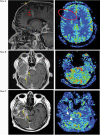Case series review of neuroradiologic changes associated with immune checkpoint inhibitor therapy
- PMID: 34055372
- PMCID: PMC8153815
- DOI: 10.1093/nop/npaa079
Case series review of neuroradiologic changes associated with immune checkpoint inhibitor therapy
Abstract
While immuno-oncotherapy (IO) has significantly improved outcomes in the treatment of systemic cancers, various neurological complications have accompanied these therapies. Treatment with immune checkpoint inhibitors (ICIs) risks multi-organ autoimmune inflammatory responses with gastrointestinal, dermatologic, and endocrine complications being the most common types of complications. Despite some evidence that these therapies are effective to treat central nervous system (CNS) tumors, there are a significant range of related neurological side effects due to ICIs. Neuroradiologic changes associated with ICIs are commonly misdiagnosed as progression and might limit treatment or otherwise impact patient care. Here, we provide a radiologic case series review restricted to neurological complications attributed to ICIs, anti-CTLA-4, and PD-L-1/PD-1 inhibitors. We report the first case series dedicated to the review of CNS/PNS radiologic changes secondary to ICI therapy in cancer patients. We provide a brief case synopsis with neuroimaging followed by an annotated review of the literature relevant to each case. We present a series of neuroradiological findings including nonspecific parenchymal and encephalitic, hypophyseal, neural (cranial and peripheral), meningeal, cavity-associated, and cranial osseous changes seen in association with the use of ICIs. Misdiagnosis of radiologic abnormalities secondary to neurological immune-related adverse events can impact patient treatment regimens and clinical outcomes. Rapid recognition of various neuroradiologic changes associated with ICI therapy can improve patient tolerance and adherence to cancer therapies.
Keywords: autoimmune encephalitis; brain metastases; immune checkpoint inhibitors (ICIs); immune-related adverse events (irAEs); neuroradiology.
© The Author(s) 2020. Published by Oxford University Press on behalf of the Society for Neuro-Oncology and the European Association of Neuro-Oncology. All rights reserved. For permissions, please e-mail: journals.permissions@oup.com.
Figures







References
-
- Suarez-Sarmiento A Jr, Nguyen KA, Syed JS, et al. . Brain metastasis from renal-cell carcinoma: an institutional study. Clin Genitourin Cancer. 2019;17(6):e1163–e1170. - PubMed

